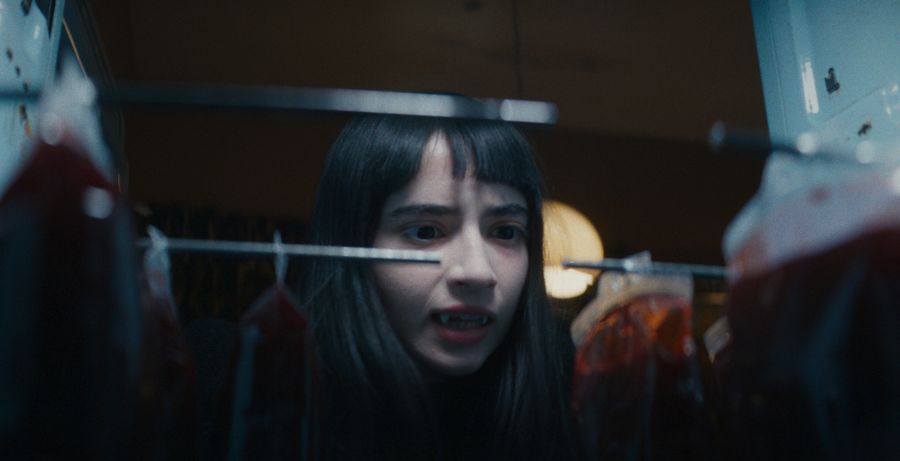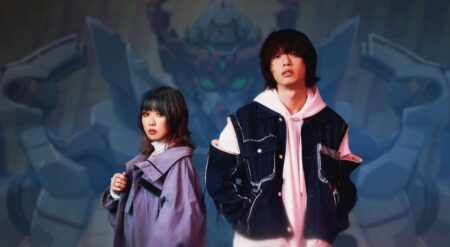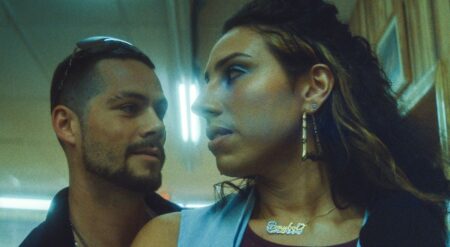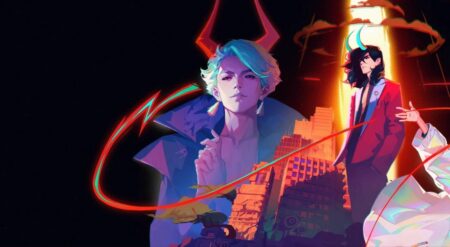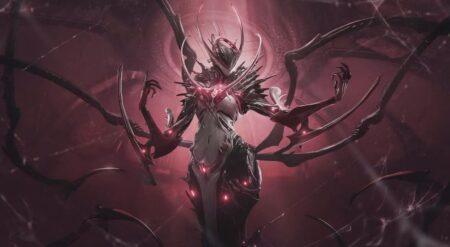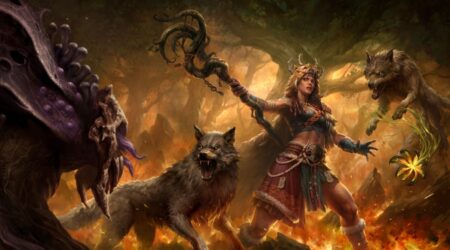The vampire is a fascinating vehicle to explore themes of loneliness, death, and even belonging, after all, we’re talking about a mysterious creature that has lived for many years feeding off the blood of other beings. But what happens when a vampire refuses to kill? Ariane Louis-Seize’s Humanist Vampire Seeking Consenting Suicidal Person explores the answer to this question through a creative blend of coming-of-age, horror, and dark comedy.
Coming off two astonishing performances in Maria Chapdelaine and Falcon Lake, young Canadian actress Sara Montpetit hits yet another home run as Sasha, a highly sensitive teenage vampire who refuses to hurt humans to feed herself. After dealing with much pressure from her family to claim her first victim, Sasha stumbles upon a potential solution: Paul (Félix-Antoine Bénard), a lonely and introverted teenager with suicidal tendencies willing to give his life to feed Sasha.
“It’s a film about death, of course, but also about life and our need for human connection and friendship,” said director Ariane Louis-Seize in an interview with But Why Tho? “It’s also a tale about two outcast people, each in their own world.”
The award-winning short films Wild Skin and Shooting Star are clear examples of Louis-Seize’s knack for portraying captivating, sometimes odd, stories about unconventional young women characters exploring their identity, or going to some sort of awakening. In Humanist Vampire Seeking Consenting Suicidal Person, Luis-Seize’s feature debut, Sasha’s thirst for blood is treated as a metaphor for sexual awakening, leading to a variety of intelligent, funny, and highly creative subversions of the coming-of-age genre. “I made parallels with the sexual awakening and her fangs coming out. When she tried to bite for the first time, to kill for the first time, it’s a little bit like the first time you want to have sex,” shared Louis-Seize. “It was a little bit like a classic coming-of-age in that sense, but with a vampire twist.”
The movie, which had its world premiere at the Giornate degli Autori of the 2023 Venice Film Festival, takes themes such as death and teenage anxiety and molds them into a tale that is as much whimsical as it is sensitive, all through smart use of the vampire figure. “I thought it was a good playground to talk about really deep human matters because vampires live for so long, they need to kill to be alive, and they are also so lonely,” said the director. “I think it’s a way to talk about our need to be loved and of human connection”.
Humanist Vampire Seeking Consenting Suicidal Person is a triumphant supernatural thrill ride, and to learn more about it I talked with director Ariane Louis-Seize about its themes, the figure of the vampire, her horror inspirations, Sara Montpetit’s brilliant work, as well as the process behind some key characters and scenes. You can read the conversation below.
BUT WHY THO: To start off, can you tell us in your own words what is Humanist Vampire Seeking Consenting Suicidal Person?
ARIANE LOUIS-SEIZE: It’s a film about death, of course, but also about life and our need for human connection and friendship. And it’s a dark comedy coming-of-age vampire tale about Sasha, a young vampire who can’t kill people because she’s too sensitive. Thankfullym she meets with this young teenager, Paul, who has had suicidal thoughts since his childhood, so he decides to give her his life. So, it’s kind of a win-win situation for them. But it’s also a tale about two outcast people, each in their own world, who kind of find themselves.
HUMANIST VAMPIRE SEEKING CONSENTING SUICIDAL PERSON Trailer | TIFF 2023
Ariane Louis-Seize’s deadpan horror comedy finds droll humour in the plight of a young Montreal bloodsucker who can only feed on people for whom she feels sympathy. Get ready for the 48th Toronto International Film Festival this September 7-17. Become a Member by August 21 for early access to tickets.
BUT WHY THO: What was the starting point for this film? When and how did you decide to use the figure of a vampire to talk about these issues of belonging, death, and depression?
ARIANE LOUIS-SEIZE: I’ve always liked vampire stories, genre films, and supernatural worlds. Since my childhood, I’ve been attracted to those films and I’ve always liked outcast characters as well. So I think it’s coming from lots of little sparks from childhood. When I was young, I watched The Hunger, a vampire story with David Bowie, Catherine Deneuve, and Susan Surrender. What a casting! It was the first time that I was really attracted to this world where vampires are not just bloodthirsty creatures but they have more depth too. I thought it was a good playground to talk about really deep human matters. Because vampires live for so long, they need to kill to be alive, and they are also so lonely. Also, I think it’s a way to talk about our need to be loved and of human connection. I always thought it was a good way to approach a serious matter. But more specifically with this film, it popped up in my head this idea of this vampire who can’t kill people because she thinks her own life is not more valuable than the lives of others. What if people who want to die contact her? It was this simple idea that I had and I pitched it to one of my really good friends, Christine [Doyon], who co-wrote the film with me. She’s a wonderful dialogist and she’s really fun and we have the same sense of humor.
BUT WHY THO: I’m vegan, so while watching the film, mostly the first act, the way Sasha talks about her not wanting to kill other living beings to survive, I thought the movie was going to be full-on vegan. Was that analogy or connection something that ever crossed your mind?
ARIANE LOUIS-SEIZE: Yeah, of course. I tried to make connections between our struggles as humans and transpose them into the vampire world. It was a parallel a little bit with us killing animals to survive and the ethical thoughts around it. Also, I made parallels with the sexual awakening and her fangs coming out. When she tried to bite for the first time, to kill for the first time, it’s a little bit like the first time you want to have sex. It was a little bit like a classic coming-of-age in that sense but with a vampire twist.
BUT WHY THO: I was just going to ask about this. The whole scene in Sasha’s room with Brenda Lee’s music. I think it’s fascinating and intelligent because it’s structured like your classical coming-of-age scene where two awkward teenagers are about to have sex. They don’t know how or what to do, but in this case, the purpose is something more sinister. Can you walk me through the scene? How was the writing process? The little choices like the red lighting, and the dance, how did you pull this off so beautifully?
ARIANE LOUIS-SEIZE: The writing of the scene was in three parts. This scene is long. You have the first part where he’s really curious about vampires and asks a lot of questions. Then you have the song and these beautiful moments where they connect together; this part wasn’t really in the script. I took a lot of time choosing the right song, then, I rehearsed it with the two actors, so I could be precise with all the movements. But all those small moments weren’t scripted. With the DP [Shawn Pavlin], we decided to do a single shot to make this moment mesmerizing and not just super long; all these little choices we made are what made the scene so powerful.
BUT WHY THO: The whole cast is amazing, but Sara Montpetit is astonishing. I watched her in Falcon Lake too and she’s amazing. She’s clearly special. How did you cast her and how was working with her?
ARIANE LOUIS-SEIZE: Yeah, I had this feeling that she would be a good vampire because she’s super mysterious: You could actually believe that she’s a 68-year-old vampire! I felt she was my Sasha, but I made audition sessions to be sure. She was super good. When I put her with Félix-Antoine, who played Paul, it was the right choice: the connection between them… they were like two weirdos in different ways, it was touching and weird and awkward, and that was the tone that I was looking for. So yeah, the short answer is I wanted her from the start and she kicked ass in the auditions. Working with her is incredible because she’s really intelligent and is not afraid to ask questions and bring her opinion, and I’m really open to that. I felt like it was a rich collaboration.
BUT WHY THO: To your point about her being mysterious, I remember, after watching the film, I scrolled her Instagram feed and I thought: “Yep, this woman was perfect for the role, this is the Instagram of a vampire.”
ARIANE LOUIS-SEIZE: Funny story, Charlotte Le Bon, who directed Falcon Lake, told her “You have to play a vampire someday.” She helped her rehearse for the audition and told her “If they don’t take you, they are crazy.”
BUT WHY THO: What are some of your horror inspirations for this film? What’s your favorite movie vampire?
ARIANE LOUIS-SEIZE: I have two. Only Lovers Left Alive and A Girl Walks Home Alone at Night. Another fun fact is that in my first short film, Wild Skin, I made the actress watch A Girl Walks Home Alone at Night because I really liked its mysterious characters, and I wanted her to be inspired by this vibe. So in that first film, I kind of wanted to make a vampire movie without making one.
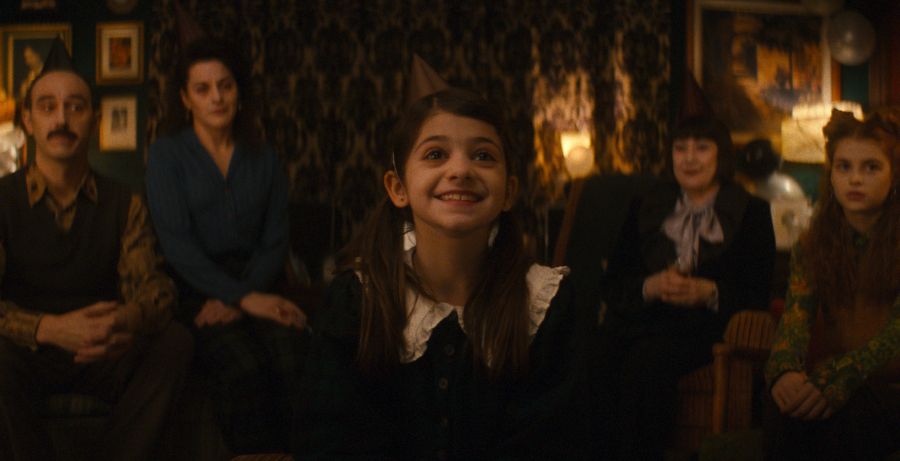
BUT WHY THO: Talking about mysterious characters, there’s this clear interest in your filmography in exploring female youth through unconventional, mysterious, or conflicted characters. Where does this fascination come from?
ARIANE LOUIS-SEIZE: It’s a good question. It’s hard to pinpoint where my inspiration comes from because I always think I make different films. I really like to play with attraction and repulsion, mixed feelings where you can’t really know where to go with them. It can be frightening as well as really exciting. I like those gray areas. There’s also the desire. I like to play with hidden urges and hidden desires because I think we all have internal conflicts with them. I don’t know. It’s nice to explore the deep internal humanity of a character.
BUT WHY THO: Please tell me a little bit about the musicality of the movie. We’ve got the great “Dracula Yéyé” song. There’s Pierre-Philippe Coté’s score which is playful but also very sweet. How did you select these songs and how did you work with Coté to deliver a score that reflects in such an effective way the tone of the film?
ARIANE LOUIS-SEIZE: First of all, it was my third collaboration with Pierre-Philippe Coté. The creation process for the film was to go to his country house where he has his studio. I spent a lot of time with him while he created the score. I had lots of direction at first, maybe too much direction. My first idea was to never use piano because that’s Sasha’s instrument and I didn’t want to use that in the soundtrack. But at some point, we just left behind all these strict ideas and just played with the film, and what we created together was so fun. This guy is a music genius, he brings a lot of emotions and he tries a lot of things. It was a really fun time. I can say also that for the music that I created with Pierre-Philippe, I wanted something playful, but also moody because that’s how I see this film. I wanted to do something fun, but also with depth. And I wanted to bring nostalgia to it because vampires are super old characters.
For “Dracula Yéyé”, it was Sara Monpetit who sent it to me. She told me “I thought of you and I just wanted to cheer you up with this song, it’s so fun!” And in editing, I was thinking again about it. I was like “Okay, I need this song. It’s so much fun!” So it was Sarah’s suggestion.
BUT WHY THO: And one last question. The JP character, we all know a JP. How did you write him? Is there a story behind it?
ARIANE LOUIS-SEIZE: It’s not really a waste to kill this guy, but we wanted to create a character that you don’t really think is going to stick in the film, but when he does, you’re like: “Oh, yeah!” I wanted him to not be just a regular douchebag, but the more you see him you realize he’s a really sweet guy. It’s this attraction-repulsion that I was talking about, it’s kind of expressed in the character of JP as well. He’s annoying as hell, but at the same time, you have a soft spot for him. So yeah, that was the idea.
After its world premiere at the 2023 Venice Film Festival, “Humanist Vampire Seeking Consenting Suicidal Person” will screen at the 2023 Toronto International Film Festival. You can learn more about the film as well as its upcoming festival run on its Instagram page (@vampirehumaniste.film).

